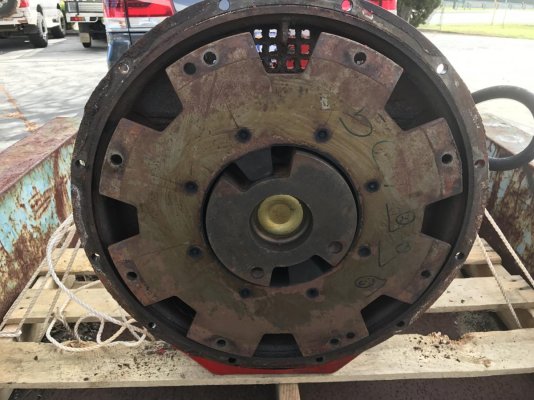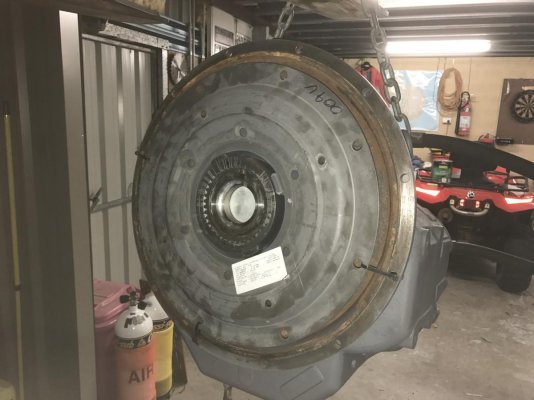catalinajack
Guru
Recently, I had the damper plates replaced on my two Lehman 120s. The engines have 5,500 hours and there is no indication in the maintenance records (some blank spots) that the plates were ever replaced. There is only one reference to the plate having been “inspected” at 2,500 hours when one of the Velvet Drives was serviced. The service life on Lehman damper plates is generally estimated at 2,500 hours. We are leaving to do The Loop next may and I did not want to worry about a damper plate failing.
I had a yard do the work. I know how to do it and also have a brother who is an experienced Lehman mechanic. However, we are both in our later sixties and this kind of work is no longer in our best interests. Two boat units, all in. Well worth the money (to me).
Instead of “standard” plates, I used R&D Marine plates sourced from PYI of Lynnwood, WA. The plates are three (3) times the cost. Many folks might not choose this option because of the cost but once I had seen the plates that had been removed compared to the construction of the PYI plates, I was quite happy with the choice I had made. The old plates where, I think, rather flimsy sheet metal. The PYI plate is machined from solid steel about 3/8 inch thick.
Here’s what the website says about the plates:
R&D Marine Damper Drive Plates are designed to prevent gearbox rattle at low engine speeds, which allows an engine to operate through its entire RPM range. Today's marine diesels are designed with lightweight flywheels which do not create the inertia of an older heavy flywheel. The lighter flywheels result in gear chatter or rattle at low RPM's. This rattle translates into gear wear and damage to the drive-train. Our damper plates eliminate this problem.
Three types of damper plates are available for different applications:
1. A "Linear" damper plate is designed for general applications. This damper provides a linear dampening of the torque applied to the system.
2. A "Hammer Head" damper plate is designed for general use where motoring at low Rpm's is common. This damper provides a two stage dampening of the torque with 10 degrees deflection of the element.
3. A "High Deflection" damper plate is designed for use in vessels where low RPM engine use is the norm as in work boats or where gear noise is being experienced. The "HD" damper gives three distinct stages of dampening with 33 degrees deflection of the element, virtually eliminating gearbox rattle for extended use even at idle speeds.
All styles of these damper plates use a molded polyurethane element to absorb the engine torque. The fail-safe design of the plate makes sure that even in the unlikely event of a flexible element failure (from severe shock load), the drivetrain system would remain functional. The back plates for the R&D Marine damper plates are punched and ready to install. They can be installed within the existing space of a metal damper.
Operating result: the new plates are as advertised. At idle speed the engines run noticeably smoother. Gone is the harmonic vibrations that, with Lehmans, only disappear when the RPM is increased. Yesterday, I had to idle outside our fairway while the marina folks cleared our berth that was occupied in our absence. The owner had not moved his boat timely as agreed. The Lehmans purred quietly the entire time. Plus, although it may be my imagination, it seems that engagement with the transmissions is smoother as well. These plates do not employ springs that can break and literally stop a running engine if lodged in the bell housing just right.
I had a yard do the work. I know how to do it and also have a brother who is an experienced Lehman mechanic. However, we are both in our later sixties and this kind of work is no longer in our best interests. Two boat units, all in. Well worth the money (to me).
Instead of “standard” plates, I used R&D Marine plates sourced from PYI of Lynnwood, WA. The plates are three (3) times the cost. Many folks might not choose this option because of the cost but once I had seen the plates that had been removed compared to the construction of the PYI plates, I was quite happy with the choice I had made. The old plates where, I think, rather flimsy sheet metal. The PYI plate is machined from solid steel about 3/8 inch thick.
Here’s what the website says about the plates:
R&D Marine Damper Drive Plates are designed to prevent gearbox rattle at low engine speeds, which allows an engine to operate through its entire RPM range. Today's marine diesels are designed with lightweight flywheels which do not create the inertia of an older heavy flywheel. The lighter flywheels result in gear chatter or rattle at low RPM's. This rattle translates into gear wear and damage to the drive-train. Our damper plates eliminate this problem.
Three types of damper plates are available for different applications:
1. A "Linear" damper plate is designed for general applications. This damper provides a linear dampening of the torque applied to the system.
2. A "Hammer Head" damper plate is designed for general use where motoring at low Rpm's is common. This damper provides a two stage dampening of the torque with 10 degrees deflection of the element.
3. A "High Deflection" damper plate is designed for use in vessels where low RPM engine use is the norm as in work boats or where gear noise is being experienced. The "HD" damper gives three distinct stages of dampening with 33 degrees deflection of the element, virtually eliminating gearbox rattle for extended use even at idle speeds.
All styles of these damper plates use a molded polyurethane element to absorb the engine torque. The fail-safe design of the plate makes sure that even in the unlikely event of a flexible element failure (from severe shock load), the drivetrain system would remain functional. The back plates for the R&D Marine damper plates are punched and ready to install. They can be installed within the existing space of a metal damper.
Operating result: the new plates are as advertised. At idle speed the engines run noticeably smoother. Gone is the harmonic vibrations that, with Lehmans, only disappear when the RPM is increased. Yesterday, I had to idle outside our fairway while the marina folks cleared our berth that was occupied in our absence. The owner had not moved his boat timely as agreed. The Lehmans purred quietly the entire time. Plus, although it may be my imagination, it seems that engagement with the transmissions is smoother as well. These plates do not employ springs that can break and literally stop a running engine if lodged in the bell housing just right.



